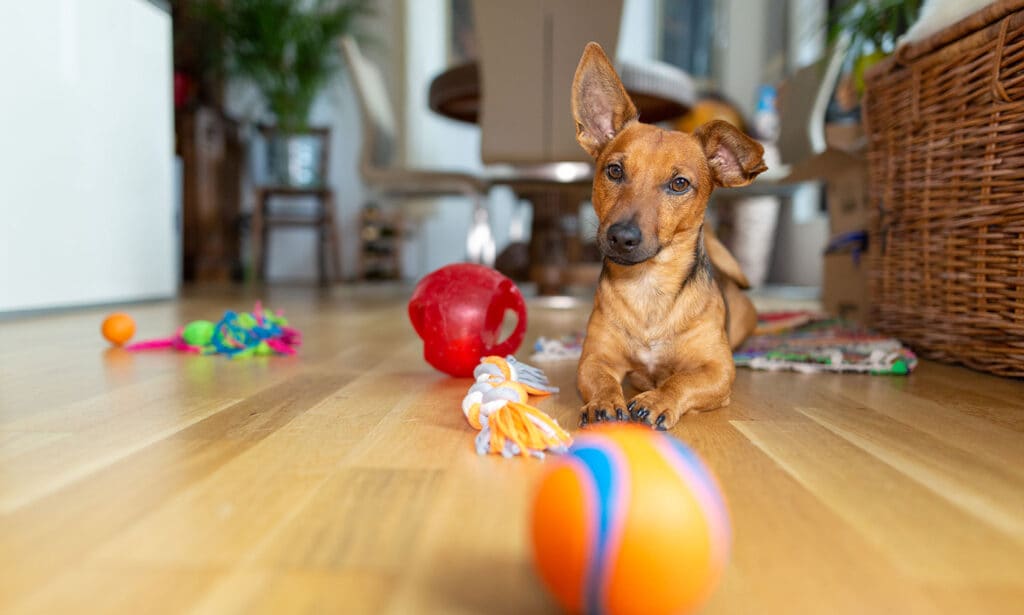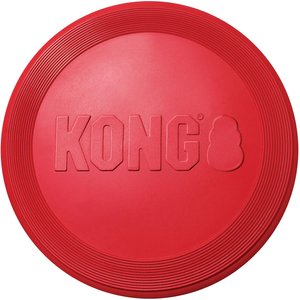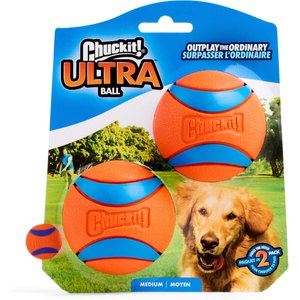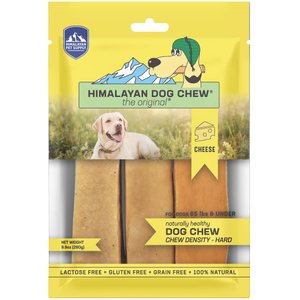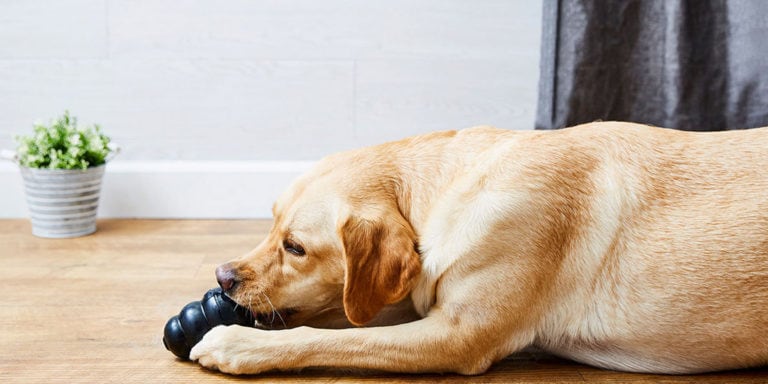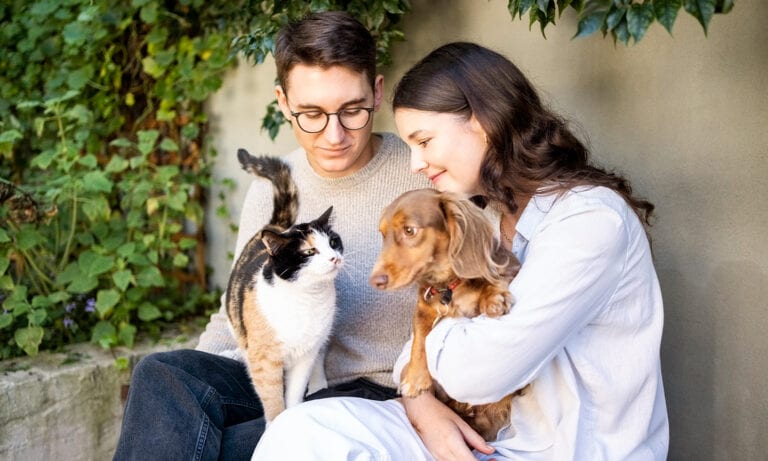If you’re anything like lots of pet parents out there, you probably feel tempted to pick up a new toy for your pooch whenever you find yourself browsing dog products online. But after looking at the colorful collection you’ve already amassed, you might find yourself wondering, “Umm, does my dog have too many toys?”
The quick answer is, technically, no. There’s not much harm in your dog having lots of toys, as long as none of them are choking hazards and you’re OK with them being scattered across your living room floor. The longer answer to this question is a bit more nuanced, though. Let’s dive in.
How Many Different Toys Should My Dog Have?
So, what’s that magic number of how many toys your pup should have at their disposal? There’s no specific minimum or maximum to aim for, according to Nick Navarro, a dog trainer and the founder of K9 Concepts in Naples, Florida. Rather, it’s about making sure your dog actively engages with and enjoys the toys they have, and that they’re getting the physical and mental stimulation they need for an enriching, healthy life.
“You don’t have to spend hundreds of dollars on an excessive amount of toys that will likely end up thrown around your house,” Navarro says. Instead, stick to just a few types of toys that your dog really likes and then let your pup enjoy them until it’s time for them to be replaced. You can also keep a few more on hand for travel and park playtime.
The Best Types of Toys for Dogs
As for which types of toys your dog needs, Navarro recommends having one toy on hand that promotes each of the following:
Exercise Toys
“Certain toys can be thrown, creating a greater cardiovascular volume for your dog and keeping them healthier,” Navarro says. Specific toy examples include tennis balls, ball-launching toys, and dog Frisbees.
Dog Training Toys
Your pooch thrives during training, and you can use certain toys as lures to help teach a cue and reward your dog for a job well done. For example, you can use a ball toy to combine training and exercise by “throwing the ball, and then recalling your dog to you,” Navarro says. In this scenario, you get to teach your dog to come when called while giving them some good exercise. (If your dog isn’t a pro with recall yet, start with a long leash to guide your dog back to you.)
Focus Toys
When your pup isn’t being active, it’s important for them to engage with toys that promote mental stimulation and focus. This helps prevent boredom and can curb behavioral issues such as barking, chewing or destruction. Durable chew toys are the best bet here because they are built to last. Navarro recommends Nylabone and Himalayan Dog Yak Cheese Dog Chews.
Comfort Toys
A tuckered-out pup probably isn’t in the mood for voracious playtime, but they can still enjoy their favorite comfort toys, such as stuffed toys and other soft toys. You can even give them an item that smells like you, such as a blanket, to help ease separation anxiety during times when you’re out of the house.
You’ll be able to tell pretty quickly which are your dog’s favorite toys by the ones they gravitate toward most often. Toys that they’re consistently disinterested in can be packed away to try again someday later or donated to a local animal shelter or rescue, provided the toy is still in good condition. (Call first to confirm.)
Best Toy Practices for Pet Parents
Though the term “toy” connotes a certain unseriousness, dog toys are actually a crucial part of your pet’s health and happiness. Toys keep them physically engaged and mentally stimulated, and provide comfort when they’re resting. Follow these best practices for toys to ensure your pooch is living their best life.
Keep Toys Clean
Dog toys get slobbery and dirty really fast. You won’t be able to keep them pristine, by any means, but do wipe down hard-surface toys weekly, and give soft toys a good washing once or twice a month. This can help keep your home tidy and minimize bacteria and contagious disease (a potential issue when toys are shared by pets).
Conquer Toy Boredom
Sally Grottini, a dog behavioral expert, notes that, over time, dogs can and will get bored with the same toys. “To conquer this, take the toys and rotate them so the dog always feels there is a new toy in play,” she suggests. “I always found it helpful to put some toys away in the closet, and when the dog got bored with the toys that were used for a while, I would switch them out for the ones in the closet.”
This also gives you a chance to wash soft plush toys to give them a fresh look. Navarro says that consistent boredom might also be a sign you should switch things up with their dog training or general exercise.
Be Mindful of Access to Certain Toys
A good way to make your dog’s toys last longer is by supervising your dog’s play. Never leave tug toys or soft toys with your dog, Navarro warns, because excitable pups will quickly shred them and could swallow the pieces, leading to an intestinal blockage. The same thing goes for balls.
Have a good game of tug-of-war or fetch, then put those types of toys away until next time. In moments of downtime, give your pup a hard chew toy that’s much more durable. (Chew toys are especially great for enthusiastic chewers. Get more advice on how to stop destructive chewing here.)
Mix and Match Different Types of Toys
You can certainly mix different toy types together. In fact, Navarro says you should have an assortment of toys for various objectives. For example, hard chews for prolonged chewing, a ball or Frisbee for exercise, and tug toys or rope toys for playing with your pup one-on-one.
Keep It Size-Appropriate
Large dogs require larger toys and small dogs require small toys. Having toys that are an appropriate size for your dog’s mouth will help prevent a toy from turning into a choking hazard and also ensure the toy is easy enough for your pup to engage with it in an enjoyable way. Be sure to read the manufacturers’ size recommendations.
Replace When Necessary
Replace your dog’s toys whenever they’re past their prime. Some signs the toy is expired include:
- Broken pieces
- Heavily torn
- Ripped seams
- The squeaker’s coming out
- Chewed beyond recognition of its original form
Take stock of your current dog toy collection to see if there are any toys you can put away for later, or whether your pet could benefit from one or two more. Remember, whether you’ve got a new puppy or a senior pooch, your pet requires both physical and mental stimulation, and dog toys are key resources for providing this.
Now, how to store all those toys (and all their other stuff)? Get tips from organization expert Marie Kondo.
Explore more toy topics:
Share:
